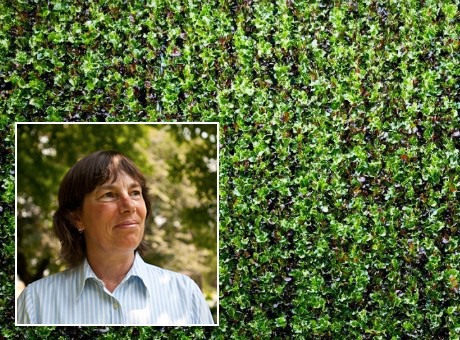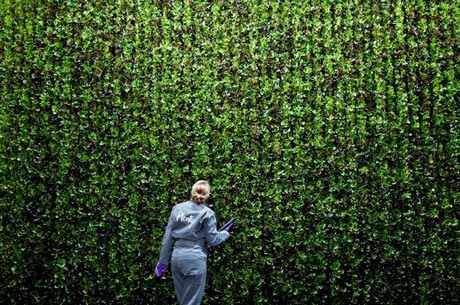To bridge the gap between fundamental research and applied science, Plenty has hired Tessa Pocock as Director of Lighting Optimization. Bringing over 30 years and over 1,000 spectral experiments on dozens of food and floriculture crops, she shares the newest light knowledge with us. "We’re writing light algorithms that make plants produce the characteristics most desired by consumers."
Plenty is one of the most talked about indoor farming start-ups of the last couple of years. After being founded in 2014 as an ag-tech company focusing on growing produce indoors, they surprised the whole world by raising 200 million dollars to expand their indoor farming business in 2017. Now the company prepares for international expansion and improvements to its vertical growing technology - and they've hired Tessa Pocock to help them with this.
"Tessa represents our leap into the fundamental sciences to bridge the gap between fundamental research and applied science. Indoor ag is one of the most opportunity-rich new industries to apply a lot of this knowledge, and I think that Tessa is the best in the field, and the research she's done is going to drive our efficiency and quality forward by leaps and bounds", Nate Storey, co-founder and Chief Science Officer with Plenty says.

Research
Tessa has been working with light and plants for over 30 years. In 2007, she was hired as Director of Research for a European horticultural LED light company. This required a new way of thinking as she saw how quickly plants responded to the spectral quality of light that LEDs allowed. Before coming to Plenty, sShe moved to academia for many years , where she helped develop the Greenhouse Lighting and Systems Engineering Consortium with Neil Mattson at Cornell.
Algorithms
During a period of research spanning twelve years, with 1,000 spectral experiments on dozens of food and floriculture crops, Tessa certainly learned a thing or two about the importance of light. "Light is one of the most important environmental factors for plants. It performs several roles in a crop’s life. Light provides all of the energy required for growth, and is an information source to direct processes such as height, branching, nutrient density and tolerance to stress", she says.
Of course, this doesn't come as a surprise to the average grower. What may come as a surprise though, is that lighting is not just a matter of putting some lamps over the crop, or even of combining colors in light recipes. "'Recipes' is not an accurate term to describe this work", Tessa explains. "What we’re doing is more complex -- we’re writing light algorithms that make plants produce the characteristics most desired by consumers."
She explains how this touches the base of vertical farming. "The opportunities of indoor farming are many. Indoor farms are perfect for areas that suffer from severe droughts, extreme weather events and lack of arable land. It is possible to maintain freshness by building the farms close to densely populated cities. The closed environment allows absolute control and consistency of crops that meet consumers' demands year-round." The consumers is also taken into account in creating the algorithm. "Algorithms are multi-dimensional and include light intensity, spectrum, duration, and timing. The lighting program at Plenty is unique as it merges applied and fundamental science while working closely with engineers to ensure high energy efficiency."
To create these algorithms, Tessa researches the crop, and the answers to the following questions start the process. "What are the optical properties of the leaves? Where does it come from and where does it grow best? How domesticated is it and where does it fit into the ecosystem? What parts do we consume? What are the nutrients that can contribute to health and under what conditions do they accumulate", she sums up. And then there's the creation of the feedback system for indoor farming. Tessa, holding three patents on remote sensing of crop plants (two pending), continues her work toward the perfect biological feedback system, as it will help to remove a lot of the guesswork that currently is used to set up environments for the different crops. "Sensing the environment and the physiological state of the plants are also beneficial as we will be able to let the plants control their environment. We have to listen to plants in a plant-based industry!"

Applied and fundamental research
Tessa explains how, in her research, she will focus on optimising the Plenty production of leafy vegetables as well as research and developments. "The optimization will be based on applied and fundamental research, carried out by all of the plant scientists at Plenty. This is what separates Plenty from others -- we are encouraged to carry out both applied and fundamental research here. This strengthens our R&D program." This has to do with the company’s long-term focus. "At a high level, universities are doing really good research but they're limited by the LEDs that are available on the market today and the speed of realizing their findings to the market. Government research centers and extension offices also add tremendous value to this field. It is difficult for growers to spend time, money and production space to research as it can be a risk and their livelihoods are dependent on production. Forward-looking farms such as Plenty offer a good place to add value to agricultural research, as we are in this for the long run."
Listening to plants
Then there's more. According to Tessa, both lighting and the regulation of crops will propel Plenty toward the future of vertical farming. "The integration of sophisticated lights and sensing systems into Plenty's farms will solve many of the challenges faced by crops grown under sole-source lighting. We can provide the highest quality crops for people by leveraging light to make them look and taste great, while maximizing nutritional content. Plenty will be using light to take advantage of and push the natural genetics that make veggies so good for us."
For more information:
www.plenty.ag
